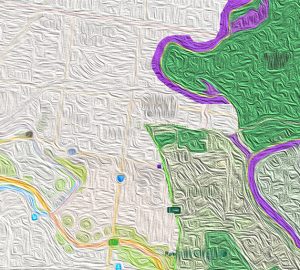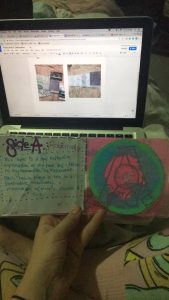Within this semesters studio, I have explored various artefacts in the form of VLOGs through to, (now upon their eventual completion) Mixtapes. When I first Entering the semester cockily certain since Project Brief One that it would be pretty cool if Granniemae made an appearance so I could tell my family back home when asked about my University conquests, that I did something like knit an obnoxious beanie. However humorous and superficial my knitting venture may have been, as the semester progressed I started finding myself interested in the effect of medium on audience reception context (Bolin, G 2015) – and the associative memories drawn through a form (Jansen, B 2009).
While creating Project Brief Four I held a new found awareness of the importance of prep time. While entering with a vision of what I wanted to achieve and explore through my finals, I set about identifying the various different tasks surrounding their creation. These tasks varied from gathering old and new media resources required, the actual physical recording of a mixtape on a two-track tape recorder, through to hand making mixed media cover art. Breaking down the project into sizeable chunks ensured that since I was chipping away for a period of time to create them – I was able to change up tasks and come back to others to keep my intentions for design and creation clear. I had three major areas which I had to develop alongside one another; Cassette Tape, CD, and two digital Spotify playlists. I began by curating two playlists which invoked personal memories arranging them in a way that tells a story of my past self contrastingly alongside my current self, (Bolin, G, 2015) choosing to utilise the same playlist across different formats so to explore the effect of form on reception.
Something I struggled with was the acquaintance with old media forms and learning how to reuse audio converting software so that the CD’s are as true to the Cassette as possible. More hours than I would like to admit were poured into attempting to relearn something that was once so fluent to me (I have never felt more like a 50-year-old woman with her iPhone font size maxed out more in my life) – a few CDs down before I realized how to fix my burning issue and I was in action. Something which I found surprisingly less challenging than once thought was the recording process of new media back to a Two-Track. Through utilising a specially supplied chord of wonder I was able to manually record my mixtape straight from my computer taking any pain out of the process (aside from my kittens sitting on my keyboard and changing the song or knocking the eject button).
Another challenge I faced while curating the playlist was a majority of the desired versions of songs I had to stream off of YouTube, aligning start times so that there wasn’t too much prominent ambient noise being caused by my computer because evidentially the only time anyone decided to message me all day was while I was attempting to do my university assignment.
As for the aesthetic of my final album art, I wanted to articulate one single concept through different explorations. Due to the emphasis on associative memory (Jansen, B 2009), I decided to play with maps through my final pieces blending the two geographical maps of my old home and my new – exploring hand drawn impositions over printed Photoshop images. The cassettes cover art also includes an approximate timeline between the dates to which the album was most relevant to me and where each song comes into play within those years. Side B also contains small taps that fold out affixed to the map that identifies various personal associations with each track.
Overall I am extremely proud of the final products I created. Both because I emphasised my aptness for creating fire mixtapes, and the fact that I was able to utilise this assignment as a personal reflection. Within this project brief, I set myself a challenge without the comprehension of how beneficial I would find it personally. The actual process while creating the two physical formats (Cassette and CD) were extremely rewarding as I was able to not only view the progress in building them up but be able to hold the final physical product in my hand knowing I had completely curated, crafted and created something that reflects on associative memories I have with people, places and things that are no longer as prominent or present in my life since relocating to Melbourne.
Through utilising the same songs to be extended across multiple mediums, I believe I created a clear and easily observed exploration of the things you gain and loose across format both aurally and in regard to audience reception context.
My final products utilise a handmade aesthetic so to greater explore associative memories in regard to music mixtapes (Jansen, B 2009). I regret, however not exploring the process behind printing onto blank disc faces to produce a crisper final product. – however handmade album art aligned to be a stronger way to explore the way in which associative memory changes between forms. While it would have been interesting to explore, I believed due to the variations in media I was producing due to time constraints it was important to streamline how I wanted to direct my craft – while being a perfect opportunity for my inner Kmart Craft nerd to shine. For Project Brief 4 I was able to utilise my craft to build upon my past decoupage exploration, while continuing to draw on ideas generated within PB3 through my exploration of the handmade role behind craft and the way in which “mixtapes encapsulate the point of time of their creation (Jansen, 2009, p.45).







References:
Bolin, G, 2015, ‘Passion and nostalgia in generational media experiences’, European Journal of Cultural Studies, vol.19, no.3, pp.250-264
Jansen, B 2009, Tape Cassettes and Former Selves: How Mix Tapes Mediate Memories, Sound Souvenirs, 1st ed, Amsterdam University Press, Amsterdam, pp.43-54.